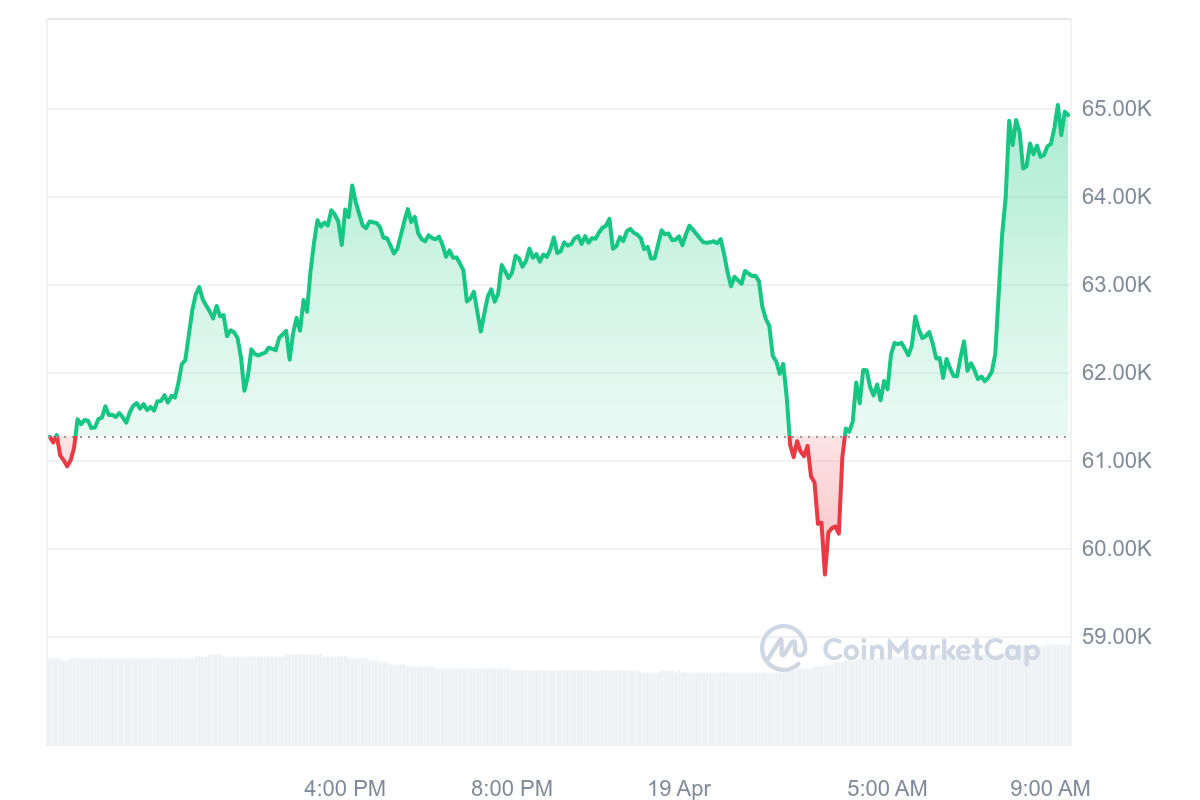Bitcoin Holders Shift $1.75 Billion to ‘Accumulation’ Wallets Amidst Dip
Please note that we are not authorised to provide any investment advice. The content on this page is for information purposes only.
Bitcoin holders transferred $1.75 billion worth of BTC to accumulation wallet addresses in a single day as the BTC price plummeted below $63K earlier this week. The transfer was disclosed by CryptoQuant on April 17.
Bitcoin Holders BTC Transfer Breaks Record
According to CryptoQuant data, the transfer of over 27.7K BTC was made between April 16 and 17, surpassing the previous record of 25,500 BTC (almost $1.6 billion) sent to such wallets on March 23, when Bitcoin price was around $63,500.
Accumulation addresses are wallets that have only received transactions but show no withdrawals, indicating that the owner has purchased coins but not sold any. A wallet must have been active in the last seven years and hold a balance of more than 10 BTC to be classified as an accumulation address.
However, addresses associated with miners and exchanges are excluded from this classification, as they are involved in the selling side of cryptocurrency transactions.
CryptoQuant data indicates a notable increase in buying activity around the $63,000 mark, suggesting that major investors are confident in accumulating and holding Bitcoin for the long term. This is similar to how experts like Robert Kiyosaki had advocated for a long-term investment in Bitcoin.
Meanwhile, market analysts, including the pseudonymous trader Rekt Capital, believe that the current period may be the last opportunity for Bitcoin holders to purchase Bitcoin at relatively low prices before a post-halving rally.
In a post on X, Rekt Capital noted that Bitcoin’s price movements mirror patterns seen in previous halving cycles. It suggested that the recent price decline, which has seen the BTC price drop by over 14% from its peak, was expected as part of a “pre-halving retrace.”
3 Phases of The Bitcoin Halving
1. Final Pre-Halving Retrace
Bitcoin has produced two -18% retraces prior to the Halving in the span of just over a month
In mid-March, BTC pulled back -18% before recovering to $70000 and now in mid-April BTC has retraced -18% again
This… pic.twitter.com/2BKBQXpPOV
— Rekt Capital (@rektcapital) April 17, 2024
Rekt Capital also predicted a “re-accumulation phase” for Bitcoin following the halving event scheduled for April 20. It added that this phase has a history of lasting over a year (385 days).
However, due to current market conditions, Rekt Capital suggests that this phase could be shorter, indicating that the BTC price may rise more quickly than in previous cycles.
Latest BTC Price Dip Aligns With Analyst Prediction
On February 5, Rekt Capital explained that the upcoming Bitcoin halving would have five phases. The first stage, called pre-halving downside, sees bearish price movements due to Bitcoin holders anticipating the halving event.
5 Phases of The Bitcoin Halving
1. Pre-Halving Downside phase
Approximately 70 days remain until the Bitcoin Halving in April 2024
Historically, any deeper retraces that occur during this orange period tend to generate fantastic Return On Investment for investors in the… pic.twitter.com/I2F7EkBqYa
— Rekt Capital (@rektcapital) February 5, 2024
The second stage is the pre-halving rally, which records major BTC price increases due to short-term traders and Bitcoin holders keen to reap the rewards of the halving mainstream hype.
A pre-halving retracement is the third stage, which is believed to be the current phase. This stage entails holders and investors exiting their positions due to sell pressures.
The fourth phase, known as re-accumulation, is predicted to kickstart after the halving takes place and will see stagnant BTC price movements, which is closely followed by the fifth state, the parabolic uptrend.
It could be recalled that Bitcoin briefly plummeted below the $60K level during the past 24 hours, but the asset has since rebounded back towards $64.9K, with 100 blocks left before the halving event.
JUST IN: 100 blocks remain until #Bitcoin halving. pic.twitter.com/w6NkuxlqF5
— Watcher.Guru (@WatcherGuru) April 19, 2024

This price movement coincides with Rekt Capital’s analysis, suggesting that the market is following the anticipated phases leading up to the halving, which involves holders and investors selling their positions, leading to temporary downward pressure on the price.




